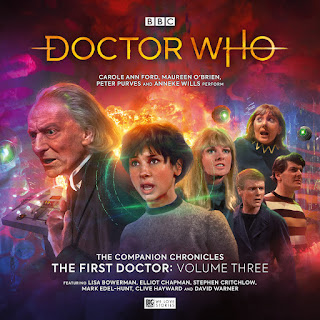 In this episode, Barbara kicks a lot of ass--including Ian’s.
In this episode, Barbara kicks a lot of ass--including Ian’s.But first things first.
The crew finds that Barbara is a guest of Morphoton, a fancy, hedonistic, vaguely Roman city whose handful of people seem awfully eager to serve her and her friends. In fact, the apparent leader of Morphoton, Altos (Robin Phillips), claims they can give the quartet anything they desire--in Susan’s case, a new dress; in the Doctor’s, a comprehensive new lab....
...and in the case of the disembodied brains that are the real rulers of this city, a fresh batch of human bodies to feed and serve them. Unfortunately for them, the mesmeric device that saps their wills and provides the illusion that this is actually happening accidentally falls off Barbara’s forehead and she now sees the true shabby nature of the place and decides to fight back...and locates Sabetha, Arbitan’s daughter, and one of the keys.
Now, don’t get me wrong--we’ve seen that Ian was intended to be the muscle of the show, and we’re coming up on William Russell wrestling with an Aztec warrior and heaving him off a pyramid in the next serial. But this is Barbara’s show. She escapes from the Morphotonians, she breaks the hypnotic spell that’s keeping Sabetha in thrall, and she breaks free from Ian’s stranglehold and fucks the alien brains’ shit clean up. This particular sequence was pure joy to me because I just did not expect Action Barbara at all.
As I mentioned in the last episode, however, there’s a...sloppiness to Terry Nation’s writing here. It seems awfully convenient that Sabetha is found here at their first stop given the emphasis she was given in Arbitan’s ‘here’s what you have to do’ soliloquy, and that she has the actual key as opposed to--as everyone else seems to have--a nasty old piece of junk the brains tell her is the key. I almost get the nagging feeling that Nation had ideas for four stories he didn’t want to bother fleshing out and created a fifth story to act as a wrap around. Yes, Graham Williams does this during the ‘Key To Time’ sequence, but each segment was its own serial. Here it feels like ‘here’s the premise, here’s Barbara reigning down her Schoolmarm Vengeance on the villains, now let’s move on’....I’ve seen a review that claims this episode stuffs a lot into it, but it feels more rushed than anything else.
And then there’s the final scene, where the Doctor decides that with three keys remaining, they should split the party (joined by Altos and Sabetha) into....two? It would seem natural to split the group into three given there are now six people in the party, with the Doctor and Susan going off on their own and Ian and Barbara each teaming with one of the newcomers. But instead, Nation has the Doctor go off to the location of the fourth key while everyone else seeks out the second. That seems a bit silly, given how even at the point the series is portraying Hartnell as particularly frail. Granted, it could just be that ego has replaced crotchitiness as Hartnell’s primary personality trait, but still....
I should mention that until I got a real close view of the disembodied brains, I thought the villains were cartoon snails with extremely long eyestalks, and that their ‘screams’ as Barbara literally brings the hammer down on them aren’t the most convincing. I also wondered if Dave Gibbons was having flashbacks to Altos’ costume in this episode when he designed Ozymandius.
I am still in on this serial. So far, we’ve gotten some fun stuff. But I am beginning to see what my friend Jeff Smith said about Nation not being the strongest script writer--or, as I suspect, that he’s got a tendency to not think through or fully develop the ideas he has. I’ll have to see how this serial develops before I can make up my mind on this.










































